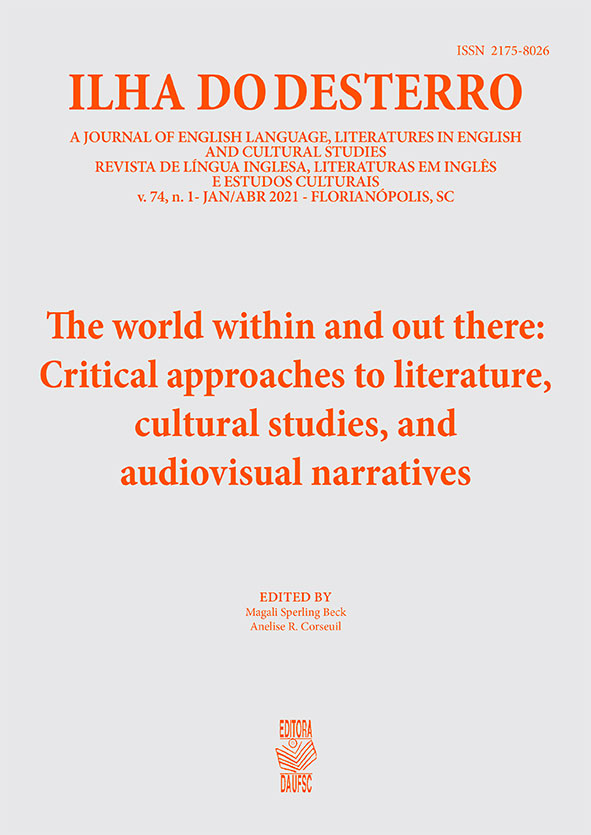Descrevendo a dor na peça documentário No Escape, de Mary Raftery
DOI:
https://doi.org/10.5007/2175-8026.2021.e74644Resumo
O teatro documentário é um gênero em que fontes e eventos reais são usados e editados para se tornarem a forma de textos dramáticos e performances. As experiências pessoais narradas em No Escape (2010), uma peça documentário de Mary Raftery, chocaram muitas pessoas devido às várias descrições gráficas de abuso infantil que ocorreram em escolas industriais e orfanatos na Irlanda. Este artigo analisa como a dor é apresentada em No Escape, contrastando a linguagem utilizada por autoridades, vítimas e representantes de diferentes instituições, em suas respectivas falas na peça. A dor, como sensação física e psicológica, é um assunto que ainda precisa ser examinado mais detalhadamente em discussões sobre a história da Irlanda para fornecer aos estudiosos e à sociedade uma oportunidade de refletir sobre este assunto - e, talvez, alcançar a cura.
Referências
Arcanjo, Miguel. “‘Queremos que o público brasileiro dialogue com teatro irlandês’,
diz Domingos Nunez, da Cia Ludens.” Blog do Arcanjo. 19 Oct. 2015, https://www.
blogdoarcanjo.com/2015/10/19/queremos-que-publico-brasileiro-dialoguecom-
teatro-irlandes-diz-domingos-nunez-da-cia-ludens/og do. Accessed 16 Oct.
Bastos, Beatriz Kopschitz, and Shaun Richards. “Introduction.” Contemporary Irish
Documentary Theatre, edited by Beatriz Kopschitz Bastos and Shaun Richards,
Bloomsbury, 2020, pp. 1-6.
Cantrell, Tom. “Verbatim Theatre: An Introduction.” Drama Online. Methuen and
Faber, 2012, www.dramaonlinelibrary.com/genres/verbatim-theatre-iid-2551.
Accessed 8 May 2020.
Cetra, José. “Cia Ludens e o Teatro Documentário Irlandês. Palco Paulistano.” 14
Apr. 2015, http://palcopaulistano.blogspot.com/2015/12/cia-ludens-e-o-teatrodocumentario.
html. Accessed 16 Oct. 2020.
Cormick, Sheila. “The Darkest Corner: Documenting Institutional Abuse and Its
Consequences at the Abbey Theatre.” Irish Studies Review, vol. 20, no. 2, 2012, pp.
-191.
Dawson, Gary Fisher. Documentary Theatre in the United States: An Historical Survey
and Analysis of Its Content, Form, and Stagecraft. Greenwood Press, 1999.
Dillane, Fionnuala, Naomi McAreavey, and Emilie Pine. “Introduction: The Body
in Pain in Irish Literature and Culture.” The Body in Pain in Irish Literature and
Culture, edited by Fionnuala Dillane et al., Palgrave Macmillan, 2016, pp. 1-19.
Hammond, Will, and Dan Steward. “Introduction.” Verbatim Verbatim: Contemporary
Documentary Theatre. Oberon Books, 2008, pp. 9-13.
Haughton, Miriam. Staging Trauma. Bodies in Shadow. Palgrave Macmillan, 2018.
Hickey, Kate. “Remembering Mary Raftery – Irish Journalist Who Exposed Child
Abuse in Ireland.” Irish Central. Jan. 2020, www.irishcentral.com/roots/history/
mary-raftery-death. Accessed 29 Apr. 2020.
Horn, Sandra, and Marcus Monafo. “Theories of Pain.” Pain: Theory, Research and
Intervention. Open University Press, 1997, pp. 1-16.
Howard, Aideen. Participation in the event “Ways of Representing the Past –
Documentary Theatre in Ireland and Brazil,” organised by Irish Memory Studies
Network, at UCD Humanities Institute, 18 Nov. 2014, soundcloud.com/ucdhumanities/
representing-the-past-documentary-theatre-ireland-brazil.
Keating, Sara. “No Escape.” The Irish Times. 16 Apr. 2010, www.irishtimes.com/
culture/stage/no-escape-1.652877. Accessed 27 Apr. 2020.
Kerr, Ian. “Shining a Light into the State’s Darkest Corner.” Independent.ie. 12 June
, www.independent.ie/irish-news/shining-a-light-into-the-states-darkestcorner-
html. Accessed 25 Apr. 2020.
Klein, Colin. What the Body Commands: The Imperative Theory of Pain. MIT Press,
Lamont, Luke. “Staging a Response: No Escape and the Rise of Documentary Theatre in
Ireland.” The Palgrave Handbook of Contemporary Irish Theatre and Performance,
edited by Eamonn Jordan and Eric Weitz, Palgrave Macmillan, 2018, pp. 777-782.
Martin, Carol. “Bodies of Evidence.” Dramaturgy of the Real on the World Stage,
edited by Carol Martin, Palgrave Macmillan, 2010, pp. 17-26.
Paget, Derek. “‘Verbatim Theatre’: Oral History and Documentary Techniques.” New
Theatre Quarterly. Nov. 1987, pp. 317-336, https://doi.org/10.1017/
S0266464X00002463. Accessed 7 May 2020.
Pine, Emilie. “Introduction.” Contemporary Irish Documentary Theatre, edited by
Beatriz Kopschitz Bastos and Shaun Richards, Bloomsbury, 2020, pp. 9-11.
Pine, Emilie, principal investigator. Industrial Memories. 2015-2019, https://
industrialmemories.ucd.ie/. Accessed 8 May 2020.
Raftery, Mary. No Escape. Contemporary Irish Documentary Theatre, edited by Beatriz
Kopschitz Bastos and Shaun Richards, Bloomsbury, 2020, pp. 12-44.
Reinelt, Janelle. “The Promise of Documentary.” Get Real: Documentary Theatre Past
and Present, edited by Alison Forsyth and Chris Megson, Palgrave Macmillan,
, pp. 6-23.
Scarry, Elaine. “Introduction.” The Body in Pain: The Making and Unmaking of the
World. Oxford University Press, 1985, pp. 3-23
Smith, James. Ireland’s Magdalen Laundries and the Nation’s Architecture of
Containment. Indiana: University of Notre Dame Press, 2007.
The Commission to Inquire into Child Abuse. 2009, www.childabusecommission.ie/
about/index.html. Accessed 29 Apr. 2020.
Downloads
Publicado
Edição
Seção
Licença
Copyright (c) 2020 Natália Elisa Lorensetti Pastore, Alinne Fernandes, Beatriz Kopschitz Bastos

Este trabalho está licenciado sob uma licença Creative Commons Attribution 4.0 International License.
A revista Ilha do Desterro publica artigos e resenhas inéditos, referentes as áreas de Inglês, Literaturas em Língua Inglesa e Estudos Culturais. Publica volumes mistos e/ou temáticos, com artigos e resenhas em inglês e português.
Autores mantém os direitos autorais e concedem à revista o direito de primeira publicação, com o trabalho simultaneamente licenciado sob a Licença Creative Commons Attribution que permite o compartilhamento do trabalho com reconhecimento da autoria e publicação inicial nesta revista.

This work is licensed under a Creative Commons Attribution 4.0 International License.



